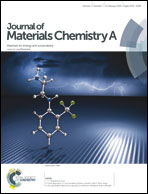Enhanced efficiency in polymer solar cells via hydrogen plasma treatment of ZnO electron transport layers†
Abstract
Bulk heterojunction (BHJ) solar cells with a solution-processed ZnO electron transport layer (ETL) were fabricated, and the effects of surface modification of the ZnO ETL by H-plasma treatment on the device performance were systemically investigated. It was found that the open circuit voltage (VOC) of the BHJ solar cells was dramatically improved after H-plasma treatment, while the short-circuit current density (JSC) exhibited a consistent decrease with increasing H-plasma treatment time. Both Kelvin probe force microscopy and ultraviolet photoelectron spectroscopy measurements indicate that the improved VOC is attributed to the reduced work function of ZnO caused by H-plasma treatment, while photoluminescence spectra suggest that the inefficient exciton dissociation associated with the H-plasma treatment leads to a decrease in JSC with tH. After 2.5 min of H-plasma treatment, the power conversion efficiency (PCE) of the solar cells was increased from 3.03% to 3.84% with a high VOC of 0.670 V, corresponding to an improvement of 27%. This work provides a novel and efficient route to improving the VOC and thus the efficiency of BHJ solar cells.


 Please wait while we load your content...
Please wait while we load your content...